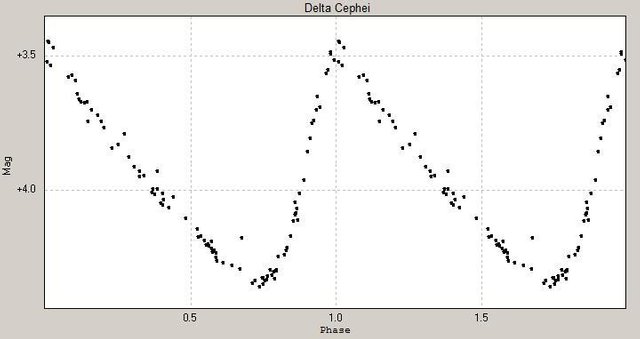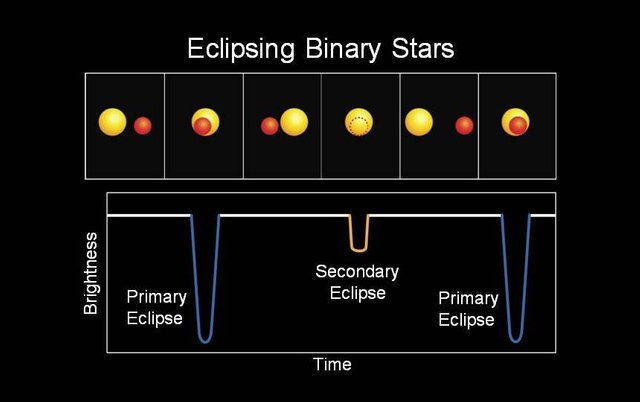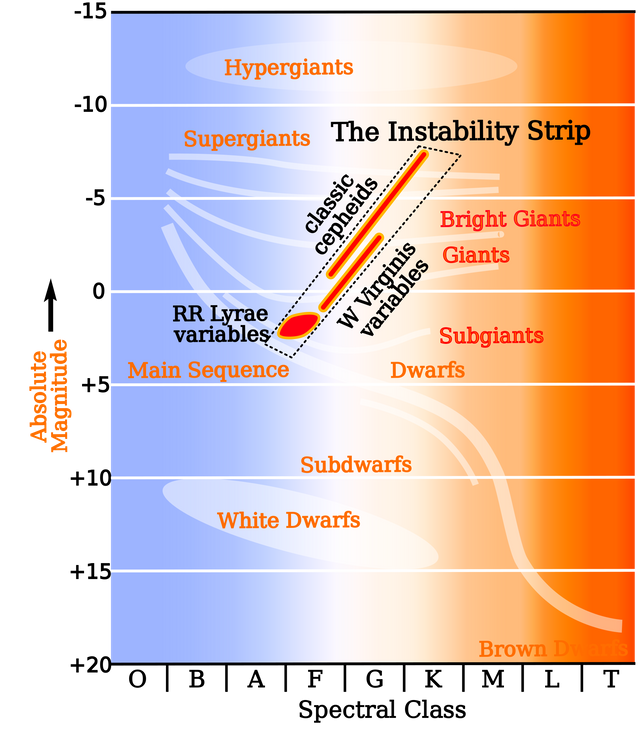Let's talk about the scale of measurement for stellar luminosity and different types of variable stars
Have you ever heard about variable stars or you have the same question as me when I read about for the first time, like how can a star be variable? Well, it can be. In astrophysics, when we measure the luminosity of a star we have a scale to measure it. For example, before we have invented the telescope we used to look at the night sky and identify the stars according to their brightness. So, in ancient time they made a scale starting from 0 to 6. The star which had 0 magnitudes was the highest in luminosity and 6 was for the stars with low luminosity. But with modern technology, we have made the scale bigger. So, there are stars even with a negative magnitude in the luminosity scale. For example, our Sun has an apparent magnitude of -26, as to us, it is the brightest object. So, what is a variable star? Well, a variable star is a star whose magnitude varies from time to time. That is a bit odd, isn't it? There are usually two reasons why this happens and according to that, we divide them.

Magnitude scale
Astronomers have been looking at the night sky ever since the starting of the civilization. It was then when people started thinking our very existence and day to day life is related to the stars. So, it was important for them to know specifically about the stars and what can be better than measuring them according to their magnitude. It was Hipparchus who is known to be the astronomer spent most of his life looking at the night sky and to identify where is which star he came up with the idea of the brightness scale. He divided it from 0 to 6, brightest as 0 and faintest as 6. But as we invented the telescope, invisible or fade star came to our sight so the scale has broadened.
Stellar magnitude can be divided into two kinds
1. Apparent
2. Absolute
Apparent magnitude is magnitude is magnitude how bright it is in the night sky ignoring the distance it is from the earth and Absolute magnitude is how bright it would look if it was 10 persec far away from us (1 parsec = 3.29 light years). This two physical quantity is related together and we can find the distance of the star if we would know both of the value of magnitude. By the way, this scale is a logarithmic scale. For every unit difference in the scale refers to 2.52 times differnce in the brightness of the stellar objects. Here is a simple equation to show the correlation.
m= apparent magnitude;
M=Absolute magnitude;
d= Distance from Sun to the star;
Here I am leaving a table to see the comparison between this
| Object [star or galaxy] | m[apparent magnitude] | M [absolute magnitude] | d [pc] |
|---|---|---|---|
| Sun | -26.8 | 4.8 | 0 |
| Alpha Centauri | -0.3 | 4 | 1.3 |
| Andromeda Galaxy | 3.44 | -21.5 | 778,000 |
Variable stars
Variable stars are those stars whose brightness varies sometimes it can be periodical and sometimes not. The first discovered variable star is named Mira Ceti. Its brightness varies over a period of 11 months time. This was one of the most important discoveries in Astronomy as before stars were thought of eternal and with constant brightness. Then Algol was discovered, which is an eclipsing binary variable star. That means when two stars are in the same system one can block the other so that brightness of the star would look different in different time.
What is the cause of variability
Variable stars are usually classified based on physical mechanism. For pulsating variable stars its the case of changing the size of the star periodically. So, the star is increasing and decreasing in their size constantly. Different kinds of pulsating stars are divided according to the light curve. The second cause of when a star block the other when they are in the binary system. Normally they have a constant brightness except one block the other. You can see that from the picture below.
Intrinsic variable star and how this kind of variable star works
Intrinsic variable stars are the star whose brightness changes for real because of the changes in size. There usually few kinds of them. The Pulsating variable is the one whose size changes periodically. Then comes the eruptive where the brightness changes because of eruption in the star and finally the cataclysmic one where the star goes through cataclysmic events like supernova or novae.
We know that a star stays stable because of gravity and pressure created from nuclear fusion in the core balance each other. But that is the normal case. Let's say some kind of unexpected perturbation happened and the star started to shrink. that means it went slightly out of equilibrium. As the star size decreased, its temperature will increase and as well as opacity. To adjust with the pressure some photons will leak out. As temperature increased nuclear fusion will try to try to take back the star in the equilibrium. So, that will create the damping oscillations. For the Variable star, this pressure can increase the size of a star more than the equilibrium position. The temperature will decrease as well as opacity. So, there will be much less leaking of photons. It can happen that the size of the star increases so much that the pressure will be so less that it will contract drastically. This process continues in the star and that's why, it's brightness is changing periodically. We call it a pulsating variable star
Different kinds of pulsating variable stars
Pulsuating star can be divided into different classes depending on the periodicity and light curve.
Cepheid is the type of pulsating star with period between 5 to 60 days.It is named after the star delta cepheid in the constellation of cepheus. It was the most studied kind of variable star. In 1908 Henrietta Levit discovered a simple relationship between their luminosity and period of oscillation which is counted as one of the most important discoveries in astronomy because it can be used to measure the distance of nearby galaxies.
RR Lyrae is another kind of pulsating variable star whose period is from 0.5 to 1 day. Can you imagine in a single night the brightness of a star changes drastically? It is named after the star RR in the constellation of lyra.
Mira ceti has the longest period measured around 100 days to years. It is named after the star Mira from the constellation cetus. Their magnitude can vary from magnitude of 3 to 9. If we measure the brightness of the pulsating stars over the time period and put the values in graph, then we get their light curve. We can easily observe how their magnitude is varying over time.

Eclipsing binary and measuring their property through the light curve
Most of the star system in the universe are binary system. Sun-like lone star system is rare in the universe. So, the question is why don't we see them so often? Well its because of the inclination angle. Most of this system behaves like eclipsing system. When one star passing in front of another its light gets blocked, the same thing will happen in half a period but only the stars will be reversed.
Let us simplify it. Let us think two stars of the same size orbiting each other. When they don't block each other we can see 100 percent brightness but when they block each other we can see only 50 percent. That creates an impression that they are variable stars. Now observing the change of magnitude over time we can make a graph and see dips in the graph on those parts when a star blocked the other. Reading those dips we can know almost all the properties of the two stars.

For example, let us look at the picture above and see that one dip is deeper than the other. What does it say? Well, it says that one star is brighter than the other and so their surface temperature is different. When the less bright star blocks the brighter it will create the dip minimum.
How to measure the distance of Cepheid and use it as an indicator
Cepheids are very bright stars. They can be observed even though they are so far away. When we can measure the period of a Cepheid we will be able to count their luminosity and from there we can find apparent and absolute magnitude. Then the job is simple. Let's put these values in the equation I described above and that will give us the distance. This distance can be used as an indicator of measuring the distance of nearby stars. So, let's say the cepheid we are measuring has period 50 days and comparing to another measured cepheid it has apparent magnitude 20 and absolute -4. So, the distance will be 630000 pc. So, that is all for today. Please don't forget to leave a comment if you have any opinion or question. A special thanks to @scienceangel for mentoring me.
References
<1>Erika Böhm-Vitense, Introduction to Stellar Astrophysics
<2>Olga Atanackovic, General Astrophysics
<3> Space.com
<4>.hawaii.edu
<5> Spacebook


Congratulations @rifkan! You have completed the following achievement on Steemit and have been rewarded with new badge(s) :
Click on the badge to view your Board of Honor.
If you no longer want to receive notifications, reply to this comment with the word
STOPAnother nice explanatory article, bro! Didnt knw abt this variable star thing. The most interesting thing is, these stars moves with their friends, not alone like our sun. xD
Cheers!
Thanks. Well, there are originally two. one you mentioned where the brightness varies because one block the other so the brightness decrease and the other is a single star where brightness increase and decrease because their size increase and decrease as well. Its like from tennis ball to footbal and then going back to it and doing it periodically.
wew, tht thing is really interesting. Thanks for explaining, bro.
Back in the 1950s, I was a volunteer member of the American Association of Variable Star Observers, the AAVSO, that I became aware of through my monthly subscription to Sky and Telescope magazine.
They sent me a set of printed star charts of specific parts of the sky that showed the magnitude of stars in a field of view centered around a variable star under study. Based on the apparent magnitude of each nearby star, and using my six inch reflecting telescope, my task was to estimate the magnitude of a selected short term variable and record the time and date. The reports were sent to the AAVSO.
Thank you for the post that recalled that memory.
Wow, that seems like a great adventure and working on the 1950's that was like the early stages of this field. I am happy that I recalled you at that time.
It was an adventure for a young kid and I felt that I was participating in something worthwhile.
Wow nice @willymac , These observations are still being done today, using the very same techniques. Not too much has changed apart from the increasing use of CCD photometry.
@rifkan, good work on this article. The magnitude scale is a bit confusing at the start, not only is it logarithmic but also smaller numbers are brighter. So at one end we have the sun at mag -26.7, but at the other end I think mag 31 is the faintest detection ever recorded (I remember reading this somewhere).
I remember the angst from trying to decide if the star being studied was closer in brightness to this star or that star. It was as if the structure of the universe were hanging in the balance.
Thanks, yes it is -26 for sun and faintest for 31 in modern measurement but in the beginning, I talked about Hipparchus scale when we didn't have a telescope. the scale was only between from 0 to 6 then it was broadened in both negative positive axis.I am not sure as well that the concept of negative number existed during his time as I am talking about ancient Greece. Logaritmic scale is basically a law in psychology which later modified is Astronomy as it obeys the relation between absolute and apparent magnitude @terrylovejoy
This post has been voted on by the steemstem curation team and voting trail.
There is more to SteemSTEM than just writing posts, check here for some more tips on being a community member. You can also join our discord here to get to know the rest of the community!
Great and comprehensive post on this topic! Just to add some grains of salt: Variable stars are for instance used in searches for dark matter (actually, galaxies made mostly of dark matter) as standard candles (in particular the Cepheids you mentioned).
Thanks @lemouth. I am really happy when i get such a wonderful comment specially when it comes from you. I didnt have any idea about this what you added about the search for dark matter. Thanks for mentioning this :) There is always something new to learn :)
This is just so true for everyone! ^^
Hi @rifkan!
Your post was upvoted by utopian.io in cooperation with steemstem - supporting knowledge, innovation and technological advancement on the Steem Blockchain.
Contribute to Open Source with utopian.io
Learn how to contribute on our website and join the new open source economy.
Want to chat? Join the Utopian Community on Discord https://discord.gg/h52nFrV
This is something incredible, and you just wrap it up very well @rifkan. I am reading about "flat earth" lately LOL
Hahaha Flat earth lol
Congratulations @rifkan! You have completed the following achievement on the Steem blockchain and have been rewarded with new badge(s) :
Click on the badge to view your Board of Honor.
If you no longer want to receive notifications, reply to this comment with the word
STOPDo not miss the last post from @steemitboard: